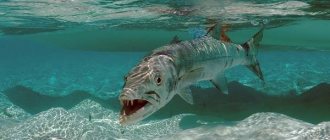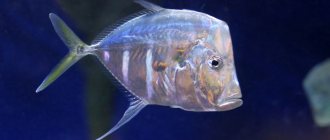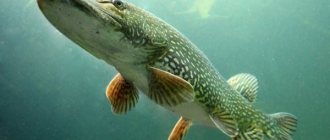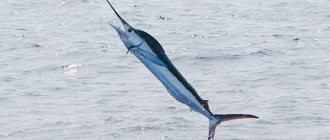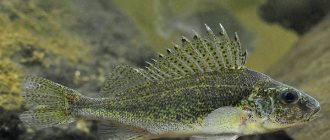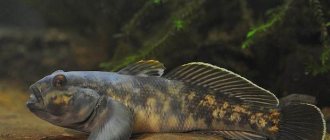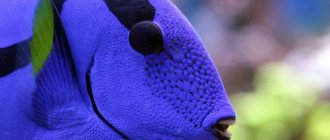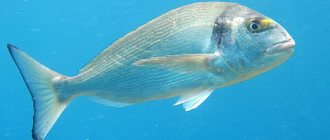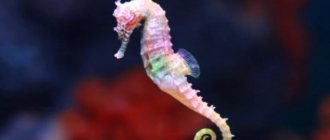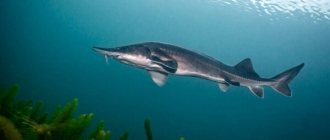Barracuda is a dangerous predator and belongs to the genus of marine ray-finned fish. The habitat of this animal is in the warm waters of the oceans and seas of the tropical and subtropical zone. This terrible creature does not live only in the Arctic Ocean. The adult loves to be on the surface of the water in the open sea. Small representatives of the species prefer quiet and muddy backwaters on the coast or in shallow water. Barracuda settles in places where you can hide or hide, or hide during the hunt. Hidden places can be: coral reefs, small caves in the rocks, algae thickets.
According to the description, the barracuda has a head and body shape resembling a torpedo. The lower jaw, which protrudes forward, gives it a terrifying appearance. On the outside is a row of small, sharp teeth, and on the inside are large fangs. A terrible sight. A large and wide tail helps to move very quickly in the water. On the back of this fish there are two fins separated from each other. The cycloid scales on the carcass can be colored silver, green, gray and blue. There are faint stripes on the sides. The belly of a water monster is always much lighter than the color on its back. Interesting and terrifying facts about this sea animal.
What is a barracuda
The most common type of barracuda fish is Sphyraene barracuda - a large species with a fearsome jaw and a row of teeth protruding forward. There are 27 species of barracuda in the wild, and many are named after the regions where they are most likely to be found in large schools.
This species of fish lives in the tropics and subtropics around the world. They are easily recognized by their long, thin body that tapers towards the tail, with a slightly flat head and an unusual arrangement of lower and upper fins.
Description and features of barracuda fish
The predatory fish, which resemble a more fearsome version of the pike (called "sea pike"), have an elongated head and elongated snout with a protruding, strong jaw and rows of teeth, each resembling fangs. The gill area of the fish has no spines and is covered with small silvery scales.
A dark gray stripe is clearly visible on the body from head to tail - the lateral line. The entire body of a barracuda is covered with small scales. The dorsal fins are located far apart. The first fin has five hard spines, the rear fin has one hard spine and nine soft ones. The rear dorsal fin is very similar to the caudal fin, and the ventral fins are located low under the belly, almost symmetrical to the upper fins. The pectoral fins are thin and sharp, and the caudal fins are deeply serrated.
In color, barracudas are silver, dark gray or almost brown with a white belly. Dark spots in fish run along the lower part of the body. They also lack signs of sexual dimorphism.
The mouth on the barracuda's long snout is large, and the teeth are arranged in two rows. The front teeth are small, fang-like, and the second row has larger teeth for chewing food. Because the teeth are crooked and of different lengths, they resemble the jaw of a piranha.
Different types of barracuda have different lengths from 30 cm to 3 m. The largest known specimen weighed 40 kg.
How to cook barracuda. Barracuda recipes
Preparing the fish
Usually, right at the market, the seller cuts off the fins and guts the insides of the fish, but if this is not done, it’s okay, the skin of the fish is not thick and preparing the fish for cooking yourself will not be difficult. The prepared fish must be filleted: cut in the middle and remove the backbone, which can be easily separated. Then you need to dry the meat: you can let the water drain on its own (20-30 minutes) or dry it with a paper towel. Afterwards you can start cooking. Here are a few recipes we tried using this fish meat.
Fried barracuda in batter
- Cut the fillet into strips four to five centimeters.
- Prepare the batter: flour, water or beer, pepper, salt. It’s good to season the batter with the famous Fukuoka pepper; it’s a fragrant seasoning for any occasion.
- Pour oil into a deep frying pan and heat it. Dip sliced barracuda fillet strips in batter and fry in hot oil until golden brown.
- Serve with rice and vegetables
Barracuda on the grill
- Prepare fillet pieces of the required size
- Rub the meat with a mixture of pepper and salt, pour in lime juice and let marinate for 20-30 minutes.
- Bake on the grill or grill until done
Pasta with barracuda in creamy sauce
- Prepare the minced meat: finely chop or grind the barracuda meat, separate the small bones. You can add an egg to the minced meat.
- Fry the garlic in vegetable oil, add the minced meat and simmer together for a few minutes, then pour in a small amount of cream, stirring over low heat, simmer for a few more minutes.
- Boil durum wheat pasta and season it with the resulting sauce.
Lifestyle and habitat
The most common habitat for barracuda is the oceans, but some species can be found in bodies of water with less saltiness. The largest species of fish, Sphyraena sphyraena, live in the Mediterranean Sea and the Atlantic. Sphyraena picudilla is most often found on the Atlantic coast of America - over a long distance from North Carolina to Brazil and even Bermuda. Other fish species are distributed throughout the world.
Barracuda is a very independent fish. Almost immediately after hatching, the fry are able to obtain food for themselves. They live in shallow water and at this time they themselves become easy prey for predatory fish. Older fish go to depth, and when they reach 8 cm, the fry move away from the coast. After the fish grows to 30cm and becomes an adult, it moves towards the open ocean. Barracudas gather in schools, which distinguishes them from most other species of predatory fish. Most often, predators live separately, and an adult barracuda is quite capable of dealing with enemies on its own, but fish of this type try to stay together.
The behavior of sea pike does not depend on the time of year, since it almost always lives in the warm waters of the World Ocean. The fish is active at any time of the day, so it either swims or hunts. The character of the barracuda is influenced by the weather: during a storm, the fish becomes more aggressive, voracious and shows its character. During a strong storm, barracuda can be found in shallow water, closer to the shore. Fish love to hide in vegetation, literally burying their heads in it. On a sunny day, barracudas are rarely seen, but in general they do not live in one place and are constantly “traveling.”
Description of sea pike
The fish has a long and muscular body, its head looks like an elongated oval, slightly pointed. It has strong teeth and front fangs, which also resembles the head of a pike . The lower jaw protrudes beyond the upper part. There are 2 fins on the back and one on the tail. The first dorsal fin has 5 sharp and spiny ray-shaped processes.
The body length of an adult can reach 2 m, the average weight is 5-8 kg, but there are recorded data with caught fish weighing 46.7 kg. Barracuda can reach speeds of up to 43 km/h. The average life expectancy is 12 years. complex relationships with their relatives . Even a minor wound on the body increases the risk of being eaten by its own fellow creatures.
The color of a barracuda's scales depends on its species. It can be silver, green or gray-blue. The belly is much lighter than the back.
Types of barracuda and habitats
There are 20-26 varieties in total, all of which are characterized by fairly large body sizes.
The most famous are the following:
- large barracuda;
- guachancho;
- silver;
- Japanese;
- yellowtail;
- striped;
- blunt-nosed;
- red;
- Australian and others.
All species live in the seas of the Pacific, Atlantic and Indian oceans. The subtropical climate is an ideal living condition for them.
The large barracuda lives off the coast of Central America. Sometimes it is mistaken for a shark. The individual is quite large, but because of its toxicity it is not of interest to fishermen. Another species (striped fish) is found off the coast of East Africa and Japan. It is small (up to 60 cm in length), but very tasty and highly valued by the Japanese .
Many silver barracudas live near Southern California and Mexico. It is the basis of fishing in American cities. The Red Sea is home to 8 species of marine predators. From the Mediterranean Sea, where 4 species are found, small-scaled barracuda sometimes enter the Black Sea. They live at shallow depths, waiting for their prey among stones or in thickets. They can attack anchovies and the like in small flocks and pursue them for a long time. But at the same time, they very rarely gather in large flocks. Even in areas where they are abundant, barracuda are rarely caught by trawl, usually using hooks .
Diet
The main diet of sea pike is represented by marine inhabitants, most of which are:
- horse mackerel;
- crustaceans;
- squid;
- shrimps;
- anchovies.
Very often, large individuals attack large marine inhabitants, especially if the fish is injured or weak. The predator hides among reefs and rocks, where it can stalk its prey . After which it delivers a strong blow to the prey with its entire body and tears it with sharp teeth. Thanks to its coloring, the motionless huntress remains unnoticed for a long time. An adult needs at least 2 kg of fish per day. She has a large appetite and may accidentally eat a poisonous creature while searching for prey. And this sometimes leads to the death of the predator.
The large barracuda feeds on the meat of puffer fish that live among the corals. The fish accumulates toxic substances in its fins, which is why it becomes poisonous for consumption.
If a sea pike tastes human flesh, it will result in severe poisoning on health. She often attacks a person, inflicting many wounds that cause severe pain and do not heal for a long time. About half of victims of an attack die from loss of blood or lack of strength to swim to shallow water.
Barracuda prefers to hunt fish with shiny scales painted in gold or silver shades. Many accidents are caused by shiny objects on divers' suits or sudden movements. The fish pays attention to this and attacks, because it takes it for its prey.
Reproduction and offspring
The sea predator can actively reproduce throughout the year. Males reach sexual maturity at the age of 2−3 years, females at 3−4 years. While sea pike can go hunting alone, during the breeding season the fish gather in large schools.
Spawning occurs in surface waters. The productivity of an adult and sexually mature individual reaches 250 thousand eggs.
Comfortable and warm conditions contribute to the rapid emergence of fry. Almost immediately after their appearance, they go hunting, but sometimes they themselves turn into victims of their parents and other inhabitants. As the cubs grow older, they change their habitat to bodies of water with greater depth.
Reproduction and lifespan
Male barracudas become sexually mature at 2-3 years, females at 3-4 years. Fish breed all year round, for which they gather in large schools. Even individuals who like a more solitary lifestyle join the rest of the school of fish to participate in mating games.
Barracudas reproduce throughout the year by external fertilization. In this case, females lay eggs on the surface of the water, and males fertilize them. A young female is capable of producing up to 5 thousand eggs, a large adult – up to 250 thousand. The caviar is, as they say, pellagic - that is, it floats freely in sea water, the fish does not care for it in any way. After the fry hatch, they find refuge in shallow water (sometimes swimming into warmer river beds).
Pike fish spawning
Females are ready for reproduction 3 years after birth. Males take 5 years. They mate in coastal water at a depth of up to 1 m. The water temperature is low to 6 0C, the ice has just melted. At this time, the water is saturated with oxygen, which will allow more eggs to survive; there are no predators eating the eggs.
Small fish are the first to spawn. Each female is surrounded from the side and above by several males. Big pike spawn last. Individuals behave noisily, rubbing against reeds, bushes and other vegetation that gets in their way.
After spawning, females sometimes jump into the air. One individual lays up to 200 thousand large eggs, which roll off and develop in the bottom soil.
Barracuda feeding
Barracuda is a dedicated predator. That is why its own meat is so tasty and healthy - like most edible predatory fish. Most often, barracuda has the following diet:
- Other types of fish that are smaller in size than the sea pike itself. Most often it is sardine or tuna.
- Small squids.
- Crustaceans.
- Bloodworm.
- Roe of other fish.
Barracuda loves to eat. Every day an adult requires several kilograms of provisions. This largely explains the restless and active lifestyle of the fish - it is constantly in search of prey. A barracuda can wait for prey alone, hiding in thickets, rocks or between corals (this type of hunting is often compared to the habits of a moray eel), or drive prey in a group. Larger individuals prefer solitary hunting. Young animals hunt in a school: they choose a large school of fish, surround it from all sides, driving it in and causing panic inside the school. In such turmoil, the fish, driven and discouraged by such pressure, as a rule, gets caught in the teeth of a predator.
Adult barracudas can stalk prey for a long time, waiting for the perfect moment to attack. Fish do not disdain hunting their relatives. Therefore, the barracuda constantly needs to ensure that it itself does not become prey to its larger brother. It often happens that while hunting in a school, one fish attacks another. This is largely due to the barracuda's aggressive nature and indiscriminate hunting. If during a hunt in a school one of the fish was wounded, it may well become the prey of its relatives. In terms of bloodthirstiness and degree of aggression, barracudas are often compared to sharks.
Sea pike attack larger fish only in schools. As a rule, a large individual is already wounded by that time and cannot fight back much. Barracudas bite her until the prey weakens.
Top 3: the most interesting facts about barracuda
- Nature did its best and gave this wonderful fish all the qualities of a good hunter. The barracuda is very fast and can reach speeds of 40 to 56 km per hour. This dangerous creature has excellent vision; the fish sees perfectly even in muddy water.
- Barracudas love to eat anchovies, horse mackerel, and sardines. They always attack schooling fish to satisfy their appetite. But lonely individuals are also attacked, especially if they are wounded. The size of the animal does not play a big role in this case.
- These gluttons even eat pufferfish, despite the fact that they are poisonous. The barracuda does not suffer any harm to itself. But a toxin begins to accumulate in its meat, which is very harmful to humans. This poison can even lead to death.
How to choose
Small young fish should be eaten. Toxins are deposited in the fish's body due to eating plankton. Plankton contains harmful substances (as it purifies water). Therefore, with age, a special poison is produced in the barracuda’s body, which means that not all individuals are suitable for food.
For example, the maximum parameter for edible fish is a length of up to 60 cm and a weight of up to 1.5 kg. Huge two-meter or more individuals are pure poison for humans. The largest amount of poison is deposited in the liver and fins. The older and larger the fish, the more toxins it contains.
Benefits for the body
Fish meat is generally beneficial for the body, and sea pike is no exception. It contains taurine, the most beneficial acid for the body, which is not found in all foods. Taurine is responsible for regulating sugar in the body and producing insulin. The amino acid prevents hypertension and improves blood counts. During the cooking process, barracuda loses only 1/5 of its moisture, so its meat remains very tender and fatty. Dishes made from sea pike are included in the national cuisine of the Japanese and Australians.
Commercial value
Barracuda meat is considered very tasty, so the fish is caught in all regions of the world where it is found. Different parts of the world have their own signature barracuda dishes. For example, in Africa they prefer to smoke fish and use smoked meat in the national fish broth, the Japanese use it for sushi, Europeans prefer baked fillets or steaks.
Since the fish has a very intimidating appearance, large specimens make outstanding trophies, which is why barracuda is also a sport fish. At the moment there are no restrictions on catching it.
